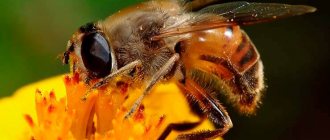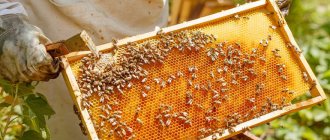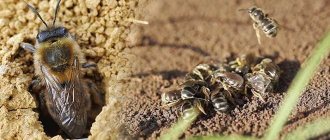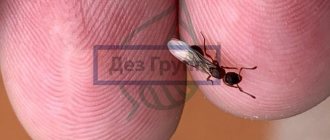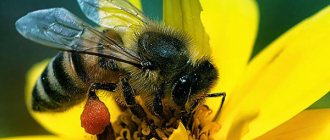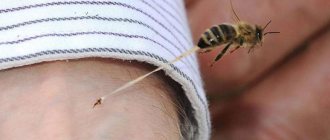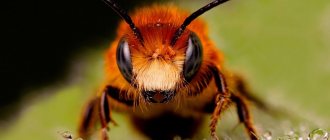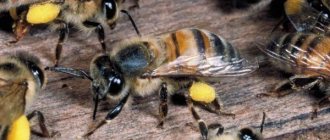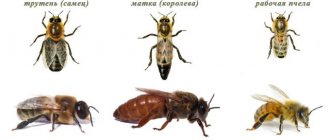In the middle of the last century, the Brazilian scientist Warrick Kerr exported individuals of the African bee from Africa to breed a new breed. This breed had an enviable working capacity and resistance to adverse environmental conditions. In an attempt to obtain bees with better qualities, the scientist crossed African individuals with European Apis mellifera. The result was a new breed called the “Africanized bee.”
During the research, by chance, 26 experimental families were released, the representatives of which had adopted not only positive, but also negative characteristics from their predecessors.
History and distribution of the breed
Just 60 years ago, African bees did not exist. They were bred by scientists during scientific research. These were originally African bees that were brought to Brazil. It was difficult for the insects to tolerate high humidity and heat, so they decided to cross them with local species. But something went wrong in the process; scientists made a mistake by releasing the queens of the species into the wild, where, under natural conditions, insects interbred with drones.
So in 1957, African killer bees began to breed in Brazil, producing excellent offspring. The incubation period for insect reproduction is one day shorter than that of ordinary bee species.
Previously, African bees were popular in Brazil, gradually displacing other bee breeds of South American origin. Insects were brought in to obtain more honey - African bees fly quickly, start their work early and finish late. When compared to other European species, Africanized bees are more beneficial because they produce twice as much product.
Beekeepers did not take into account the fact that African bees are very aggressive, irritable and dangerous to humans; they secrete toxic poison in large quantities.
This is evidenced by an incident that occurred during the next experiment in Pirachikaba; during the swarming period, the hive cells were equipped with special shutters; insects could pass through them, but the drone and the queen could not. By an absurd accident, an inexperienced beekeeper removed the protective flap, and up to 27 families of African insects flew away.
It is impossible to keep them under control, bees constantly swarm, can fly away from their nests at any time, and are constantly aggressive towards humans. A distinctive feature is that insects can fly away up to 100 kilometers.
The real Warwick Kerr
Kerr was born in Sao Paulo in 1922, into a middle-class family with Scottish roots.
He graduated with a degree in agricultural engineering and then began specializing in genetics. He worked as an entomologist for decades, and his research included the genetics of honey bees and native Brazilian bees. Warwick Ker worked on his doctoral dissertation at the University of California at Davis (1951), and then at Columbia University in New York, under the guidance of the famous Soviet and American geneticist of Russian origin, Theodosius Grigorievich Dobzhansky. One of Kerr's influential papers, “An Experimental Study of Gene Frequency Distributions in Extremely Small Populations of Drosophila Fruit,” cites Dobzhansky as an advisor and co-author. This fruit fly study was conducted in 1954 and was one of the first to deal with the emerging field of genetic statistics. As a result, Kerr has already published 620 research papers over his 60-year career.
Warwick Kerr is mainly responsible for starting genetic research in Brazil. He was director of the National Institute of Amazonian Research and worked at the University of São Paulo. Later, at the State University of Maranhão, he created the Department of Biology and worked as the dean of the university.
Warwick Kerr says his most important work was training the institute's staff, technicians, teachers and researchers. At the University of São Paulo he created the Department of Genetics, focusing on entomological and human genetics and using mathematical biology and biostatistics. Kerr is a member of the Brazilian Academy of Sciences, the World Academy of Sciences (formerly the Third World Academy of Sciences) and the US National Academy of Sciences.
I’ll end with a short video filmed four years ago. It shows that Kerr's interests shifted towards botany. The language of the film is Portuguese, but even if you don't know it, you can get a general idea of Warwick Kerr's enthusiasm and curiosity.
Description and features of the African bee
Externally, the African bee is large in size. In other respects, the bee is similar to the more familiar domesticated insect:
- the body is round, covered with small villi;
- slightly dull color with yellow-black stripes;
- two pairs of wings - the front one is always larger than the back one;
- proboscis for collecting nectar;
- segmented antennae.
A distinctive characteristic of the African bee is not only its large body, but also:
- high-speed movement;
- increased aggressiveness;
- high honey productivity compared to domestic bees;
- good physical strength and endurance;
- high viability and rapid adaptation to different climatic conditions.
Aggression by an Africanized bee can be triggered by an invasion of the hive's territory. The insect is overly sensitive and irritable - the slightest pathogen can cause a response. Even after the threat is eliminated or the stimulus ceases, the swarm will not leave its defensive positions for 8 hours.
To protect yourself as much as possible from attacks by African bees, it is important to know about the irritants to which insects react:
- extraneous noise;
- unpleasant odors;
- sharp sounds;
- bright colors;
- sudden movements.
If an attack occurs, you need to know that dangerous bees are not afraid of water and smoke - they will not be able to hide in a pond, they will wait for at least an hour to attack again.
What problems does their movement create?
The rapid increase in the number and spread of Africanized bees further and further north, in addition to the danger to people and animals and the reduction in the number of apiaries, is fraught with a violation of the biological balance. The hybrid threatens the existence of the US wild bee population not only because of its aggressiveness, but also because it carries diseases such as varroa and acarapidosis.
Important! Bee smokers and other smoke sources will not protect against killer bees. The only more or less reliable defense against attack is the smell of vinegar.
In addition, the influence exerted by the hybrid on the pollination of agricultural crops is also ambiguous (killer bees displace local pollinating insects, but are sometimes unable to adapt to the pollination of plants unfamiliar to them, which entails crop losses).
Advantages and disadvantages of the breed
Despite the fact that the African bee is a serious threat to humans and can cause his death, this insect also has positive qualities:
- considered the best pollinators;
- physically hardy, little tired;
- capable of collecting a lot of honey during the season.
The breed has many more disadvantages. They are aggressive, their behavior is completely unpredictable. Bees are prone to excessive swarming. Insects are restless, do not live in apiaries, and are constantly moving. The main disadvantage of bees is toxicity.
First aid for bites
Since the venom of a killer bee is no different in strength from the venom of an ordinary bee, the ambulance is also no different. The peculiarity of insect bites is that they are widespread, and even a person who does not suffer from allergic reactions can be seriously injured. In any case, a person who has been bitten needs medical attention, so before providing first aid you must call an ambulance.
The first aid algorithm is as follows:
- Give the victim any antiallergic drug - suprastin, diazolin, loratadine, etc.
- Try to remove as many stings from the skin as possible.
- Disinfect the affected areas with hydrogen peroxide or any alcohol tincture.
- Apply cotton wool or gauze soaked in a solution of sugar or soda to the wounds.
- Before medical help arrives, provide the victim with rest and plenty of warm drinks.
- If the condition worsens or it is impossible to transport the victim to the nearest medical center, ensure taking glucocorticoid drugs - prednisolone, hydrocortisone.
It is strictly prohibited for bee stings:
- give the victim alcohol;
- rub the bite site or squeeze it (with the exception of squeezing out the sting);
- wash wounds with water;
- apply plantain, earth, clay, etc. to the wounds;
- wrap up the victim;
- apply heat to wounds.
There are currently no specific ways to get rid of killer bees or stop their spread throughout the world. In some regions they are listed in the Red Books and are an important part of the ecosystem: despite their danger, they are excellent pollinators.
The danger of the bee and its prey
Today, information is known about deaths after stings by killer bees - about one and a half thousand people died. In the United States alone, more people have suffered than from snake bites. 500 African bee stings are comparable to one rattlesnake bite. Scientists estimate that 500-800 African bee stings are fatal to humans.
After 7-8 bites of a dangerous insect, a person experiences swelling and short-term, but very painful sensations. For a person prone to allergies, including bee products, bee stings are very dangerous, because this can provoke anaphylactic shock and subsequent death.
Previously, bees attacked rural settlements, people and domestic animals. They began to talk about people covered with many bees, screaming in wild pain.
There is a well-known story that ended in tears: in 1975, a local school teacher was attacked by a swarm of African bees. Help was provided in a timely manner, but there were multiple bites, after which the woman fell into a coma, did not wake up, and died.
More than once it was necessary to stop football matches due to aggressive behavior and attacks by bees living near the stadiums.
The danger of a bee is as follows:
- It will attack if the nest is approached more than 5 meters. The degree of its aggressiveness is 30 times higher compared to ordinary honey-bearing rocks.
- It is not just animals or humans who may be at risk from an attack. African bees are prone to attacks on apiaries, destroying regular bees or colonizing their habitats.
- When attacked by an entire swarm, the outcome for a person is always disastrous, because the insects pursue their prey for more than 500 meters.
The aggressive state of the breed remains for a very long time. Ordinary bees calm down after a maximum of an hour, African bees - after 8 hours.
Habitats
Insects come from ancestors that evolved in the tropics and are poorly adapted to long, cold winters. They are thought to be limited to tropical and subtropical habitats. Research supports the belief that Africanized polypores are behaviorally and physiologically unsuited to cold temperatures.
The native range of Africanized insects is the eastern and southern parts of Africa. Introduction to the New World began with deliberate importation and subsequent accidental release in Brazil. The spread continued through Central and South America into the southern United States.
It was found that populations of “African women” were recorded in more than a dozen counties on the Florida peninsula. Arrival in Florida contradicts the spread of A. m. scutellata from Texas. Most likely, undetected insects were accidentally brought into the state through transportation by rail.
Lifestyle
African bees also set up hives, collect honey and lead a normal lifestyle. But as soon as a person comes closer than 5-10 meters to the hive, the swarm goes into a rage. Cases have been recorded where insects chased their prey for more than 1 kilometer.
African bees are overly sensitive to extraneous sounds - they are irritated by car horns, the hum of an engine, even loud laughter. Bees are able to hear “irritating” noises from 15 meters away.
African bees are small in size, but this should not be misleading.
The only thing that bees do not like and scares them away is the aroma of vinegar. When they smell it, they simply fly away. This may help avoid fatal bites.
Appearance
Bees Buckfast
They differ in size from their honey-bearing counterparts to a greater extent; the sting is the same size. At the end of the abdomen there is a stinging apparatus, consisting of a reservoir for poison, a sting and two poisonous glands. When an insect inserts its sting, the muscles begin to contract, it penetrates deeper, the poison pours out of the reservoir and penetrates the wound.
Appearance of killer bees
Breeding prospects
Taking into account all the negative aspects of breeding, the African bee should be considered unpromising and even dangerous, because its spread causes the displacement of other breeds. Many scientists are developing plans for further crossing and breeding of new breeds. The priority is to obtain non-aggressive insects that are inclined to work hard and are characterized by high productivity.
For the first time, positive results were obtained quite recently by crossing with alpine bees, which have a calm character and are considered the best option for such experiments. It may soon be possible to eliminate the threat using the safest possible methods.
Hybrid bred African bees are a completely unique species of honey insect. They are not only aggressive, but also spread rapidly, which increases the risk of threat to human life, because insects attack for no apparent reason and not alone, but in a swarm.
Children about bees
We have prepared facts from the life of bees for curious schoolchildren:
- Bees bring income not only to beekeepers, because these insects pollinate 80% of crops and thereby increase productivity.
- Honey, containing a complex of essential vitamins and minerals, is included in the diet of people engaged in physical labor, including astronauts.
- On the island of Ceylon they eat bees; a dish made from them is considered a delicacy.
- They do not attack without reason, but they are affected by the pungent smell of sweat, perfume or alcohol; if one bee stings, the rest also rush into battle. For some reason, insects are more vicious in bad weather.
A bee sting is not fatal to humans
- For a person to die, bees must sting him 100 times.
- You can calm bees using laundry soap; its smell has a beneficial effect on insects.
- It will be interesting for children to know that our ancestors used insects as weapons, for example, Richard the Lionheart ordered to attack the enemy with shells containing swarms of bees.
- Bees distinguish people by the configuration of facial features: the shape of lips, ears and eyebrows.
- The first place in honey production is occupied by China, Russia is only in 7th place. Russians eat 300-500 g per year.
- Honey collected near roads is harmful to the body, so beekeepers try to settle closer to the forest or taiga.
Hybrid killer bee
- The ancient Greeks and Romans used honey to preserve and preserve meat.
- The guards will not let you into someone else's hive, because the smell of enzymes is different.
- After attacking a person or animal, the bee leaves a sting and part of the intestine in the body, and therefore dies. If a resident of the hive bites a wasp or hornet, the sting remains intact, and the defender of the hive attacks again.
- Killer bees are hybrids of honey insects, they are much more aggressive and sting 10 times more often. The most dangerous is the African bee.
How to avoid an African bee attack?
If a person becomes a victim of an attack by an entire swarm of African bees, this will result in death for him. But there are control methods that will help eliminate possible insect aggression:
- Use vinegar. African bees do not like the smell of vinegar, so if they need to be in insect habitats, they need to wipe themselves - this will scare away the bees.
- Keep quiet. Bees become very irritated when they hear loud laughter, the hum of a car, etc. Insects become aggressive and attack the one who makes sounds that are unpleasant to them.
- Do not wave your arms and move slowly. Such behavioral factors are not acceptable for bees; on the contrary, their effect on them is several times stronger. When near possible habitats, it is advisable to move smoothly and carefully.
At the moment, only one safe method of maximum protection is known - learning to live with bees.
Cases have been recorded of swarms of killer bees killing livestock in a short time. In addition, their presence near existing apiaries greatly affects the reduction in the efficiency of bees.
African bees are considered very dangerous insects, they are overly aggressive, and there are cases where their stings are fatal. To avoid being attacked by a killer bee, it is important not to provoke it and avoid places where it may live.
0
0
Copy link
Deciphering the sex of stingless bees
Warwick Kerr first worked with meliponas, stingless bees, instead of honey bees. Some Brazilian poor people and aborigines collected wild honey - they are called meleyres. The municipality of Meleiro is located in an isolated rural area, and is named after the Meleiros, which in turn are named after the honey trees where the Meliponas live. The Melaires have a population of 7,000, but their risky activities, which include raiding Melipon homes, worried Dr Kerr in the 1940s. He hoped his work would draw attention to the importance of conserving the meliponas, their habitats, and the people who fed on their honey. Kerr realized that if he could understand and help the Melipons, then he would help the Melaires.
Melipona quadrifasciata
Melipona quadrifasciata are eusocial stingless bees native to the southeastern coast of Brazil. The Melaires call them "Mandachaya", which means "beautiful guard", since the narrow entrance to the colony is always protected by guard bees. Brazilian meliponas build mud hives inside hollow trees. They create narrow passages through which only one bee can get through at a time. These stingless bees can sting painfully, but their complex system of passages protects them from predators.
Kerr's first influential work, Genetic Determination of the Melipona Castes, in 1949, described the production of male, female, and worker individuals in Brazilian stingless bees. Kerr discovered that their caste development differed from that of honey bees. In both species, the drones are haploid, but in the female Melipona, things are a little more complicated.
In Apis mellifera, “the larva grows into a queen or a worker, depending on the food it receives. In Melipona, the caste is determined genetically. Fertile female individuals (uteruses) are heterozygous, and some individuals have two and sometimes three pairs of genes, and homozygosity makes a worker out of an individual.” — Kerr, 1949
In the exotic Melipona quadrifasciata, alleles (half of the gene that controls heredity, say the 'b' in the 'Bb' gene) determine caste. Drones are haploid and have one set of chromosomes; queens and workers are diploid (two sets of chromosomes, one from each parent), but queens have special, specific heterozygous alleles (for example, AaBb), and workers have identical, homozygous caste-determining genes (AABB, AAbb, aaBB or aabb ). If this is difficult for you to perceive, imagine how difficult it was with the technology of the 1940s.
Bee Reproduction
The process of reproduction in bees is carried out by laying eggs. Fertilized eggs give birth to full-fledged bees. If there was no direct fertilization, then drones are born. In order for the offspring to be viable, the queen must be fertilized by drones from other families.
Queen bee development
Bee eggs go through three stages: larva, prepupa and pupa. If the number of bees in a family becomes very large, then swarming occurs. One part of the bees remains in the hierarchy with the queen, and the second part looks for a new place with a new queen.
Reproduction diagram of the queen bee
Traditional hives
In Nepal, traditional hives are used, which are made of wood or bricks. Wooden hives are made by removing the rotten part of the trunk. Such hives have a diameter of 1-1.5 ft (1 ft = 30.48 cm) and a length of 2-2.5 ft. They are installed on platforms or covers (for storage against theft and animals) (CRANE, 1990; TAPA et al., 2000b).
Brick hives are made from bricks from old houses. They have thick walls that provide good insulation for bees during cold periods in hilly areas (CRANE 1998). Research has shown that 42% of beekeepers use traditional beehives. They are used generally as bait hives. In the hilly zone, modern hives are also used: Newton hives, modified modern hives and African hives.
We invite you to read Find out about when to replant violet babies
Mexican insects
Mexican bees are descendants of insects that were brought from Africa. It is believed that the African species, released into the wild, emigrated to Mexico, as a result of which, in this country, they completely replaced the species that were there at that time.
This species has begun an active movement towards America, and their mass migration is beginning to frighten local residents. If measures are not taken to catch them in the near future, they will be able to populate the entire territory of the United States of America.
Mexican bees are less aggressive than their ancestors, but this does not mean that they are not capable of causing harm to animals or people. Statistics show that over the past few years more than 200 people have died from the bite of such insects.
Bee nutrition
Almost all bees eat pollen and flower nectar. A special proboscis is used to extract it. Through it, the nectar enters the crop, where it is converted into honey. In the process of collecting pollen and nectar, flower pollination is of great importance. In search of plants, these insects are able to fly about 10 kilometers per day.
Does Megachile Pluto give honey?
Scientists have been actively talking about whether Wallace's bee produces honey this year. Now there is such a version: Wallace's bee, like other honey bees, produces honey. But scientists were unable to detect it, since they found only one female bee in the nest (although bees usually live in swarms).
Scientists at Princeton University, who met with the missing bee, studied the appearance of the previously missing inhabitant, took measurements and released it back. Scientists deliberately did not specify the specific location where the unique insect was found, so that collectors would not take advantage of the opportunity to replenish their rare collections with a new giant specimen. They kept silent about the location of the termite mound also because there is a risk that poachers might start hunting for a rare inhabitant of the Indonesian forests, who would want to sell their find to collectors for fabulous money.
Today, this inhabitant of the Indonesian islands is listed in the international Red Book (you can find it in the special category “Data Deficient”).
